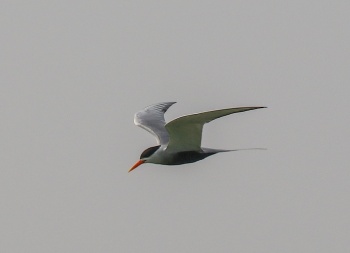(Picture added. Taxonomy corrected. Distribution.) |
Sbarnhardt (talk | contribs) (Amend Gsearch for new system, Add Gsearch Checked template) |
||
| (5 intermediate revisions by 2 users not shown) | |||
| Line 1: | Line 1: | ||
| − | |||
[[Image:BB Tern with Fish-2 fine.jpg|thumb|550px|right|Photo by {{user|vaibhav+mishra|vaibhav mishra}}<br />Chambal River, Dholpur, Rajasthan, [[India]], February 2011]] | [[Image:BB Tern with Fish-2 fine.jpg|thumb|550px|right|Photo by {{user|vaibhav+mishra|vaibhav mishra}}<br />Chambal River, Dholpur, Rajasthan, [[India]], February 2011]] | ||
;[[:Category:Sterna|Sterna]] acuticauda | ;[[:Category:Sterna|Sterna]] acuticauda | ||
==Identification== | ==Identification== | ||
| − | + | [[Image:1-30-S64A7924-3.jpg|thumb|350px|right|Photo by {{user|max1|max1}}<br />Chambol River , C. [[India]], February 2018]] | |
| + | 32–35 cm (12½-13¾ in)<br /> | ||
'''Adult'''<br /> | '''Adult'''<br /> | ||
'''Breeding''' | '''Breeding''' | ||
| Line 11: | Line 11: | ||
*Blackish belly and vent | *Blackish belly and vent | ||
'''Non-breeding''' | '''Non-breeding''' | ||
| − | *Whitish belly, no tail streamers | + | *Whitish belly, no tail streamers |
| + | *Dark tip to bill | ||
==Distribution== | ==Distribution== | ||
[[Asia]]: found in [[Pakistan]], [[Nepal]] and [[India]] to south-western [[China]], [[Myanmar]] and South East [[Asia]]. | [[Asia]]: found in [[Pakistan]], [[Nepal]] and [[India]] to south-western [[China]], [[Myanmar]] and South East [[Asia]]. | ||
==Taxonomy== | ==Taxonomy== | ||
| − | This is a [[Dictionary_M- | + | This is a [[Dictionary_M-O#M|monotypic]] species<sup>[[#References|[1]]]</sup>. |
Subspecies ''melanogaster'' is generally considered to be invalid<sup>[[#References|[2]]]</sup>. | Subspecies ''melanogaster'' is generally considered to be invalid<sup>[[#References|[2]]]</sup>. | ||
| + | |||
==Habitat== | ==Habitat== | ||
Near large rivers; breeds on sandspits, islands and marshes, up to 730 m. | Near large rivers; breeds on sandspits, islands and marshes, up to 730 m. | ||
==Behaviour== | ==Behaviour== | ||
| + | ====Diet==== | ||
| + | Their diet consists of small fish and insects. They hawk for insects over both land and water and plunge-dive for fish. | ||
==References== | ==References== | ||
| − | #{{Ref- | + | #{{Ref-Clements6thAug17}}#Avibase |
#BirdLife International | #BirdLife International | ||
| + | #Handbook of the Birds of the World Alive (retrieved October 2015) | ||
{{ref}} | {{ref}} | ||
==External Links== | ==External Links== | ||
| + | Search the Gallery using the scientific name: | ||
{{GSearch|Sterna+acuticauda}} | {{GSearch|Sterna+acuticauda}} | ||
| − | + | Search the Gallery Using the common name: | |
| + | {{GSearch|"Black-bellied Tern"}} | ||
| + | {{GS-checked}} | ||
[[Category:Birds]] [[Category:Sterna]] | [[Category:Birds]] [[Category:Sterna]] | ||
Latest revision as of 18:08, 18 February 2022
- Sterna acuticauda
Identification
32–35 cm (12½-13¾ in)
Adult
Breeding
- Orange bill,
- Black cap and nape
- Dark grey breast
- Blackish belly and vent
Non-breeding
- Whitish belly, no tail streamers
- Dark tip to bill
Distribution
Asia: found in Pakistan, Nepal and India to south-western China, Myanmar and South East Asia.
Taxonomy
This is a monotypic species[1].
Subspecies melanogaster is generally considered to be invalid[2].
Habitat
Near large rivers; breeds on sandspits, islands and marshes, up to 730 m.
Behaviour
Diet
Their diet consists of small fish and insects. They hawk for insects over both land and water and plunge-dive for fish.
References
- Clements, J. F., T. S. Schulenberg, M. J. Iliff, D. Roberson, T. A. Fredericks, B. L. Sullivan, and C. L. Wood. 2017. The eBird/Clements checklist of birds of the world: v2017, with updates to August 2017. Downloaded from http://www.birds.cornell.edu/clementschecklist/download/
- Avibase
- BirdLife International
- Handbook of the Birds of the World Alive (retrieved October 2015)
Recommended Citation
- BirdForum Opus contributors. (2024) Black-bellied Tern. In: BirdForum, the forum for wild birds and birding. Retrieved 18 May 2024 from https://www.birdforum.net/opus/Black-bellied_Tern
External Links
Search the Gallery using the scientific name:
Search the Gallery Using the common name:
GSearch checked for 2020 platform.





